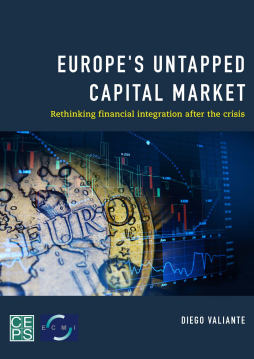
Additional Information
Book Details
Abstract
The quality of financial integration is one of Europe’s principal concerns in the aftermath of the great crisis. The lack of risk sharing lies at the heart of the financial instability produced by the rapid retrenchment of capital flows within national boundaries. The limited cross-border banking and capital markets activity is unable to provide investors with the necessary risk diversification to allow economies to withstand asymmetric shocks.
This book builds on a year-long discussion with a group of academics, policy-makers and industry experts to provide a long-term contribution to the Capital Markets Union project, launched by the European Commission in 2015. It identifies 36 cross-border barriers to capital markets integration and provides an organic plan, consisting of 33 policy recommendations, to relaunch EU financial integration. These aim to improve the key components of cross-border capital market transactions: price discovery, execution and enforcement. It also provides a comprehensive overview of the current structure and the state of integration of Europe’s capital markets.
Diego Valiante, PhD, is Head of Financial Markets and Institutions at the Brussels-based EU think tank, the Centre for European Policy Studies (CEPS). He is also a member of the Group of Economic Advisers (GEA) of the European Securities and Markets Authority (ESMA).
Table of Contents
| Section Title | Page | Action | Price |
|---|---|---|---|
| Europe's Untapped Capital Market | cover | ||
| Table of Contents | vii | ||
| Foreword | xiii | ||
| Preface | xv | ||
| Members of the European Capital Markets Expert Group | xvii | ||
| Executive Summary | 1 | ||
| I. Building Europe’s capital market: Guidelines for an action plan | 1 | ||
| Policy recommendations | 4 | ||
| II. Financial integration policies: A historical overview | 15 | ||
| III. Financial integration, risk sharing and economic growth | 16 | ||
| IV. Rationale for more capital markets integration | 17 | ||
| V. Integration and structure of Europe’s capital markets | 20 | ||
| VI. Summary table: Selected cross-border barriers* | 25 | ||
| Introduction | 27 | ||
| 1. A brief history of EU policies for financial integration | 28 | ||
| 1.1 The first wave of financial integration | 29 | ||
| 1.2 The second wave of financial integration | 31 | ||
| 1.3 The third wave of financial integration | 37 | ||
| 1.4 EU financial integration policies: a recap | 40 | ||
| 2. Does Europe need more capital market integration? | 45 | ||
| 2.1 Financial integration and risk sharing | 45 | ||
| 2.2 Determinants of financial structure and development | 59 | ||
| 2.3 Financial development and economic growth | 66 | ||
| 3. European financial market structure and integration in the CMU era | 73 | ||
| 3.1 Europe’s financial structure: the international and regional dimension | 73 | ||
| 3.1.1 Funding structure of non-financial corporations | 81 | ||
| 3.1.2 HousFiniHouseholds’ financial assets structure | 87 | ||
| 3.1.3 Matching households’ assets and NFC liabilities | 91 | ||
| 3.2 Financial integration in Europe: evidence from the euro area | 95 | ||
| 3.3 Capital market-based intermediation in Europe | 99 | ||
| 3.3.1 The structure of the dealer bank industry | 99 | ||
| 3.3.2 Asset management in Europe | 106 | ||
| 3.4 Integration in Europe’s financial markets | 126 | ||
| 3.4.1 Equity markets | 127 | ||
| 3.4.2 Debt securities markets | 141 | ||
| 3.4.3 Derivatives markets and securitisation | 156 | ||
| 3.4.4 Exchange-traded products | 164 | ||
| 4. A single market for capital in Europe: designing an action plan | 169 | ||
| 4.1 Defining Capital Markets Union (CMU) | 169 | ||
| 4.2 A diversified financial ecosystem | 173 | ||
| 4.3 Financial contracting in market-based systems | 177 | ||
| 4.4 A barriers removal test | 181 | ||
| 4.5 Price discovery | 187 | ||
| 4.5.1 Information on the underlying asset | 188 | ||
| 4.5.2 Financial instrument information | 198 | ||
| 4.6 Execution | 204 | ||
| 4.6.1 Entry procedures | 205 | ||
| 4.6.2 Exit procedures | 209 | ||
| 4.7 Enforcement | 213 | ||
| 4.7.1 Public enforcement | 214 | ||
| 4.7.2 Private enforcement | 223 | ||
| 4.8 Integration barriers: a quick recap | 236 | ||
| References | 241 | ||
| Annex 1. Matching objectives and proposals of the CMU action plan | 257 | ||
| Annex 2. Task Force Members and Observers | 259 | ||
| Annex 3. List of Abbreviations | 263 |
